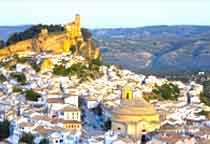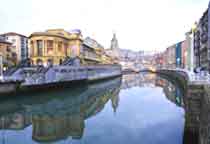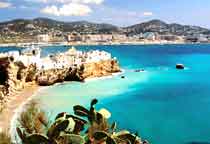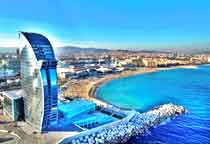Overview
Once the most powerful country in the world, Spain basks in the glory of its past. The legendary Moorish kingdom of Andalusia was a beacon of civilization during the Middle Ages, and the Habsburg dynasty that ruled Spain in the 15th and 16th centuries built an empire that extended across Europe to the Americas, Africa and Asia – ensuring that Spanish would become the world’s second most spoken native language. Today, Spain’s old superpower status and superlative wealth live on in its spectacular historic buildings and monuments – and in the vast quantities of gold that still decorate its churches.
After the Golden Age of the 17th century, Spain began a slow political decline and more recently has struggled economically. However, the country’s glorious historic legacy makes for an endlessly intriguing visit. With its magnificent monuments, beautiful beaches, majestic mountains, and sophisticated social life, Spain enchants millions of visitors every year. Many travelers can’t get enough and keep coming back.
From cosmopolitan Barcelona to romantic Andalusia, Spain is filled with attractions that offer a veritable feast for the senses. In every city, you’ll find buildings that amaze and inspire: from the immense Gothic cathedral of Seville to the glorious Baroque buildings of Madrid, and Barcelona’s breathtaking Sagrada Familia basilica – an epic 130-year building project that is finally nearing completion.
The culinary culture is as rich as it is regionally varied: from exotic tapas and rich red wines, to lively food festivals, long lunches, and – of course – afternoon siestas. To truly experience Spain, you must adapt to its rhythm and way of life. Adjust to the later meal times and take advantage of the nightlife. Learn about the religious festivals and join the locals at the piazzas. Sunbathe at the beaches and save time for museum visits. Be adventurous and sample the local cuisine, from tangy cold gazpacho soups to whole roast suckling pig. Watching a bullfight is a possibility, while chatting with the locals is mandatory – and will always make your trip more memorable.
Tourist Attractions

- Soak up the medieval ambience of Barcelona’s Gothic Quarter, reveling in the evocative atmosphere of ancient Roman temples, 14th century churches, and medieval buildings where Catalan counts and monarchs held court for 500 years. The ancient streets are a shoppers’ paradise, with everything from big-brand stores to bustling markets and dusty old antique shops.
- Take a guided tour of the stunning, instantly recognizable architecture of Barcelona’s most famous son, Antoni Gaudi. The fantastic and surreal world of Post-Modern architecture has its pinnacle in the towering Sagrada Familia basilica – Gaudi’s visionary masterpiece, which is due to be completed in 2026.
- Spend time visiting the charming medieval towns, fishing villages, castles and vineyards that stretch along the Costa Brava near Barcelona. This sunny coastal region has become very popular with discerning Barcelonians, and has a rich spread of fine restaurants and boutique hotels overlooking the Mediterranean.
- While on the east coast, be sure to savor the Valencian and Catalonian varieties of paella – the legendary slow-cooked rice dish served with chicken or seafood. Adventurous gourmands will be drawn to the famous ‘black paella’, made with rice stained with squid or octopus ink.
- Take an artistic pilgrimage to the birthplace of Pablo Picasso in Malaga, where the Buena Vista Palace in the city’s historic heart has become the Museo Picasso Malaga – housing an exceptional collection of 285 works by one of the world’s most influential artists.
- Andalusia, and particularly Malaga and Seville, have some of the tastiest tapas in all of Spain, and a tour of their charming cafes and tapas bars will show you a new side of these historic cities – and undoubtedly make you a few local friends into the bargain!
- Succumb to the haunting spirit of authentic flamenco at a traditional tablao flamenco, where the lively dances are often accompanied by delicious food and wine. Some of the better known clubs, such as Madrid’s Corral de la Moreria and Tablao Cordobes in Barcelona, feature some of the finest flamenco dancers in the world.
- Spain is renowned for her breathtaking festivals, and it’s always worth trying to synchronize your trip with one of these elaborate spectacles. During ‘Holy Week’ at Easter, many of the larger towns come alive with grand musical processions of statues and exotic floats – often borne aloft by dramatically dressed cofradias(religious brotherhoods).
- Although bullfighting is off the agenda for most conscientious travelers, Spain’s most famous ‘Running of the Bulls’ continues to draw thousands of visitors to the narrow cobblestone streets of Pamplona each morning during the second week of July. This chaotic event usually lasts just three minutes – but the parties that follow it go on all day and night!
- The ancient city of Toledo, where Arab and Jewish traditions come together, is renowned for its delicious baked goods and marzipan sweets. While touring the city’s beautiful old palaces and churches, you may find an ancient convent selling melt-in-your-mouth cookies and confectionery made by the cloistered nuns.
- Among a multitude of Spanish locations for an incurably romantic dinner, few can match the exquisite carmen restaurants of Granada – where the candlelit terraces overlook the enchanting hilltop fortress of the 14th century palace of Alhambra.
- Most of the cities of Andalusia have a beautifully renovated, ancient hammam (Arabian bathhouse), where you can unwind in a luxuriously appointed hot pool, sipping traditional teas or pampering yourself with an aromatherapy massage.
- Some of Europe’s most serene and spectacular hiking country is to be found in the Alpujarras Mountains, a region of secluded green valleys, flower-strewn hillsides, and ancient whitewashed villages scattered beneath the snowcaps of the Sierra Nevada.
Weather

Spain is blessed with an ideal Mediterranean climate throughout most of the country. Barcelona and the region of Catalonia in the northeast enjoy especially mild weather. Southern Spain is naturally the sunniest part of the country, and the Costa del Sol is a sun-worshipper’s dream destination.
Late spring, summer and early fall are the best times to take a beach vacation in Spain. August is the most crowded time at Spain’s vacation resorts, where many Europeans take their summer holidays. The Basque country offers less touristy and off-the-beaten-path destinations, although this lush region has the most rainfall – and visitors can expect rain even during the summer.
When planning a trip, it’s wise to consider the Spanish holidays, as many sites are closed during religious holidays. However, Spain’s lively festivals are often a highlight of a Spanish vacation, and it’s always worth asking your travel agent to check the festival schedules for the villages and cities you’re planning to visit. As well as the better known festivals of Holy Week, you may want to catch the Festival of the Balconies in Cordoba in May, or the Saint James Pilgrims’ Festival in Santiago de Compostela in July.
Accommodation

Spain has a wide variety of tourist accommodation, from small boutique hotels to luxurious five-star resorts. Visitors can choose from brand-name hotels like the Sheraton or charming family-run bed & breakfasts. Spain also offers a unique type of luxury hotel called paradores, which are located within historic properties such as palaces, castles, convents and monasteries. These monuments have been converted into classy hotels with all modern amenities – while preserving the authentic character and heritage of their original buildings. Many paradores are located in historic areas of a city or in parklands and nature reserves.
Visa and Passport Requirements

Most non-European Union nationals require a tourist visa only if they wish to remain in the country for more than 90 days. If you plan to stay longer than 90 days, you will need to submit a short-stay visa application at a Spanish Consulate before your visit. If you want to work during your stay, you may need to obtain a work permit.
Health and Safety
There are no health precautions for visiting Spain. The Center for Disease Control recommends that you are current on routine vaccines before your trip, including flu shots, polio, varicella (chickenpox), measles-mumps-rubella (MMR), and the diphtheria-tetanus-pertussis vaccine. Prepare to bring along any medications you’ll need packed in your purse or carry-own bag. Before your trip, you may consider travel health insurance to cover the costs of any medical emergency, and check to see if your health insurance plan will cover any medical costs incurred while traveling overseas.
Spain is a very safe country and most overseas visitors never encounter any issues. You should take the same precautions that you would traveling anywhere. You may feel more at ease walking around at night in Spain than in the United States. Even families with little ones stay out late into the evening. In busy cities like Madrid, Barcelona and Malaga, you should watch out for pickpockets. Pay special attention when you are in crowded urban areas such as a metro car or train station. Keep your passport and cash in your hotel safe or money belt. It is advisable to bring copies of credit card information in case of theft, and to purchase travel insurance to cover lost baggage.
Another precaution: watch out for Gypsy children begging for money. They may have been sent by their parents to distract you while your wallet is snatched. To avoid being duped, be aware of your surroundings and be wary of strangers who approach you for no reason. Unfortunately, car break-ins are commonplace in many Spanish cities. If you’re driving a rental car, do not leave valuables in your car. If you must leave luggage in the car, be sure to keep it in the trunk.














